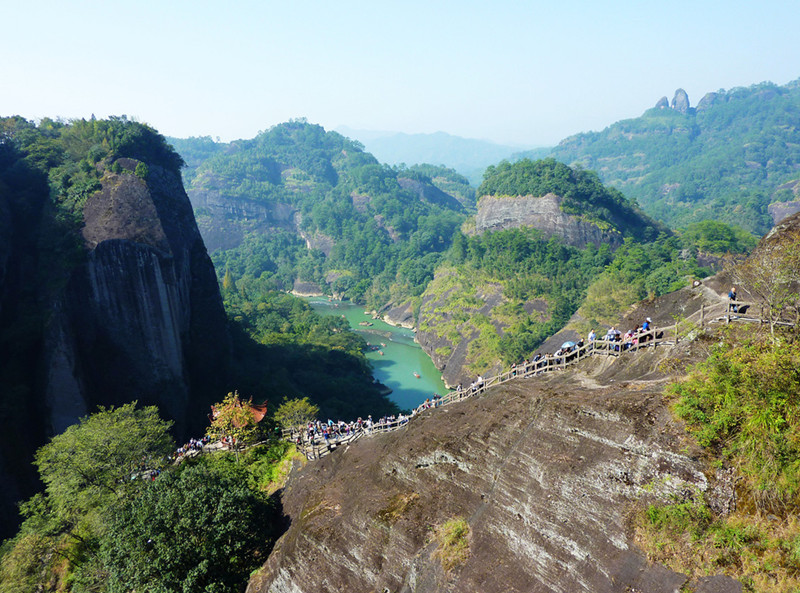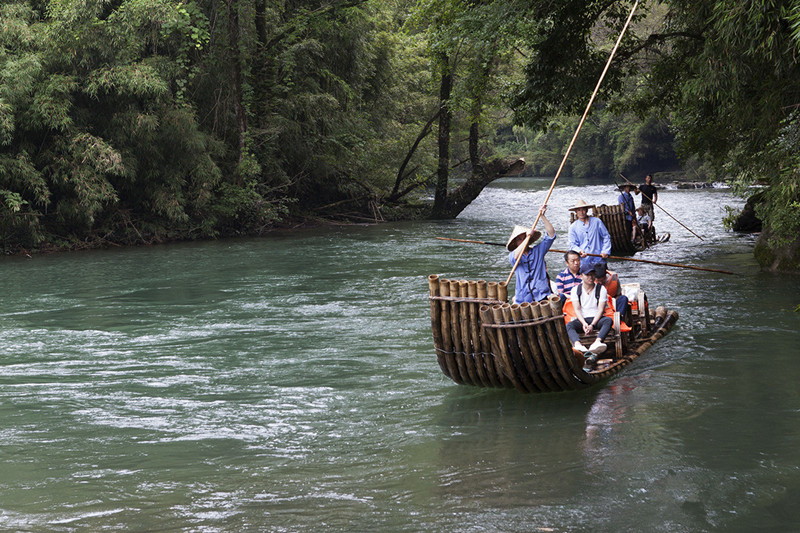
Wuyi Mountains in Fujian

The Wuyi Mountains is one of the most spectacularly beautiful areas of southeastern China. Wuyishan Nature Reserve is well known for its abundance of deep canyons, dense forests, waterfalls, animals (many of them endangered), flora and fauna. It's an idyllic destination for any nature lover.
English Name: Wuyi Mountains
Chinese Name: 武夷山
Height: highest peak Mt. Huangguang, 2,158 meters (7,080 feet)
Area: 1,000 sq. km. (386 sq. mi.)
Open: 8am–5pm
UNESCO World Heritage: since 1999
Time needed: 1–2 days
Location: Wuyishan Nature Reserve, Wuyishan City, Fujian Province
Wuyi Mountains
Located at the northwest of Fujian Province in east China, its main peak, the Huanggang Peak, rises 2158 meters above sea level, being the highest peak in southeast China. With the best preserved and largest tropical primeval forest in central Asia.
Why is Wuyi Mountains So Special
Mount Wuyi is the most important biodiversity conservation zone. In 1987, the Mount Wuyi Nature Reserve was listed as a ”Global Man and Biosphere” by UNESCO, and in 1992, the Global Biodiversity Protected Zone. The Mount Wuyi was listed as a natural and cultural world heritage in 1999. It is known as ”the most beautiful mountain in southeast China”.
Introduction of Wuyi Mountains
Covering totally 60 square kilometers, the Wuyi Mountain Scenic Area boasts its pristine environment, grotesque mountains, spectacular canyons, crystal-like water, and more importantly, a long cultural history and numerous historical relics. With a history of 12 centuries, it owns a series of excellent archeological sites and relics, including a mass of temples and academies’ ruins, Wuyi Palace, Yulin Pavilion (a Song Dynasty (960-1279) porcelain kiln site), hanging coffins, Royal Tea Garden, and cliff carvings.
Human history and culture
Human settlement on the slopes of Mount Wuyi can be traced back 4,000 years by archeological remains. During the Western Han Dynasty, the ancient city of Chengcun was the capital of the Minyue kingdom. In the 7th century, the Wuyi Palace was built for emperors to conduct sacrificial activities, a site that tourists can still visit today. The mountains were an important center of Taoism and later Buddhism. Remains of 35 academies erected from the era of the Northern Song to the Qing Dynasty and more than 60 Taoist temples and monasteries have been located. However, most of these remains are very incomplete. Some of the exceptions for which authentic remains are preserved are the Taoyuan Temple, the Wannian Palace, the Sanqing Hall, the Tiancheng Temple, the Baiyun temple, and the Tianxin temple. The area is the cradle of Neo-Confucianism, a current that became very influential since the 11th century.

Main Scenic Spots
Wuyi Mountain seems with famous tourist attractions, such as Nine Bend Stream, Cloud Nest, Hidden Scereen Peak, Tianyou Peak, Wuyi Palace, Water Curtain Cave, Yunv Peak, Roaring Tiger Rock, Lotus Peak, and Peach Tree Cave, etc. One of the most popular activities among tourists should be bamboo rafting on Nine Bend Stream.
Highlights in Mount Wuyi Scenic Area:
- Nine Bend Stream (九曲溪)
Nine Bend Stream is the soul of Mount Wuyi with the most charming scenery. Superior climate and environment give birth to the wonderful scene of ”trees growing out of rocks”. Drifting on the Nine Bend Stream, you probably lose yourself! - Tianyou Peak (天游峰)
The Tianyou Peak (Heaven Tour Peak) is located in the center of Mount Wuyi. It outshines neighboring peaks with mists and clouds. Embraced by mountains and Nine Bend Steam on three sides, it offers a panoramic view of Mount Wuyi. White clouds undulate on the mountain like big waves of the sea, making the area just like a fairytale wonderland. - Great King Peak (大王峰)
The Great King Peak is also called Heavenly Pillar Peak and Gauze Cap Peak. It looks like an official’s hat. Located on the west of Wannian Palace, it is the first peak for entering Mount Wuyi. - The Water-curtain Cave (水帘洞)
The cave is spacious and can receive one thousand visitors. The cave is fronted by a waterfall which looks just like a white curtain. In addition, the relics and ruins of temples and cliff carvings can be found inside the cave. - Wuyi Palace (武夷宫)
Originally built in Tang Dynasty (618-907), it was expanded into 300 rooms in Song Dynasty. Wuyi Palace was grandiose because it was where emperors offered sacrifice to mountain god. But due to wars and fires, only the Wannian Palace, Sanqing Palace and two wells are survived. Wannian Palace is now the memorial hall of Zhu Xi, a Song dynasty philosopher and the founder of Idealism Confucian. - Roaring Tiger Rock (虎啸岩)
Roaring Tiger Peak and Tianyou Peak are said to be two ”walls” of Wuyi Mountain. Located on the south side of the second bend of Nine Bend Stream, the Roaring Tiger Peak is flanked by abrupt cliffs on four sides. The area is known for its sea of clouds, grotesque rocks, steep cliffs and abundant springs. The Roaring Tiger Scenic Area provides different landscapes in four seasons. - One-line-sky (一线天)
The One-line-sky is also called Ling Cave. Located on the southwest end of Mount Wuyi, it is the most mysterious cave in the area. The cave is split into two parts, as if being cut through by an axe. Standing beneath of the cave and looking up, you will see a narrow sky. - The Longchuan Grand Canyon (龙川大峡谷)
The Longchuan Grand Canyon is situated within the Wuyi Mountain Nature Reserve Area. Here you will see green mountains, colorful blossoms, rare animals, especially, springs and waterfalls. Ancient trees soar up to sky and white waterfalls flow down along jagged rocks and reflected into colorful halos by red sandstones. - Da Hong Pao Scenic Area (大红袍景区)
This scenic area is located on the center of Wuyi Mountain, inside the jiulong Nest Grand Canyon. A deep valley was enclosed by lofty and steep cliffs on four sides.The scenic area also includes some other precious tea trees, Nine Dragon Cave, Yuzhu Peak, Liuxiang Brook, and some cliff carvings.

The Best Time to Visit Wuyi Mountain
June–October is the best time to visit Wuyi Mountain. It is open year round, but visitors can best enjoy the many wonders of nature during warm, dry days. Xiamen is subject to monsoon rains between June and September. During this period, the plants glow well and river is fuller.
How to Get There
- The nearby airport of Nanping Wuyishan gives visitors direct access to the town and park. Visitors can take a taxi from the airport to the city of Wuyishan, the distance being just 9 kilometers. Taxis charge 10 yuan for the first 5 km and then 2 yuan for every additional kilometer.
- Several trains connect the park from the cities of Xiamen and Fuzhou, as well as G trains from Beijing and Shanghai.
Useful Travel Tips
- A public bus operates inside the park (number 6), but most of the important sites are within walking distance of one another.
- Whether you’re interested in hiking, boating, bird watching, tea estates, waterfalls, cultural heritage sites, or simply want to explore a beautiful, pollution-free part of China, the Wuyi Mountain range offers something for everyone.
- The ticket price in the peak season (March to November) is reduced from 160 yuan to 140 yuan, and in the off season (December to February) is reduced from 160 yuan to 120 yuan (valid within 3 days)
- Take bus Wuyishan No.5 to the south entrance station of the scenic spot, and walk there.
- From March 1 to October 31 (summer), 06:30-18:00; from November 1 to February 29 (winter), 07:00-17:00; special: the garden is closed for half a day at 14:00 on Lunar New Year’s Eve, only open in the morning.
Recommended Wuyi Mountain Tour
- 3 Days Wuyishan Tour
- 4 Days Wuyishan Tour
- 5 Days Fujian Highlights Tour with Fujian Tulou and Wuyishan Mountain
Main Attractions in Fujian Province
- Longchuan Grand Canyon
- Royal Tea Garden
- Water Curtain Cave
- Jiuqu Stream
- Qingjing Mosque
- Lingshan Mountain Park
- The Islamic Holy Tombs
- Kaiyuan Temple
Edited by Lynette Fu/付云锐













